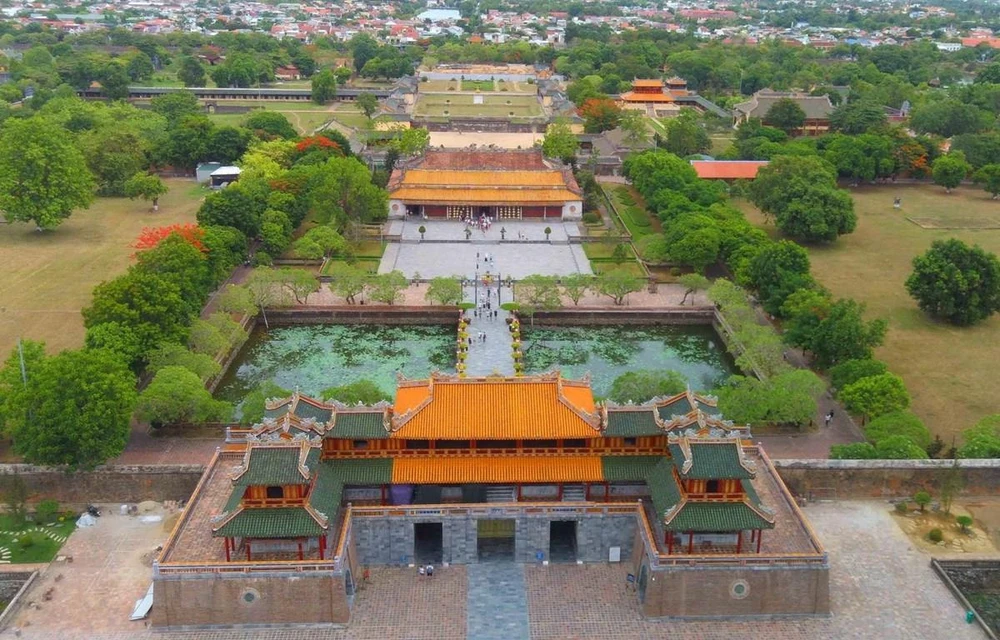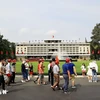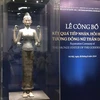
Hanoi (VNA) – Vietnam’s legal system through different periods of time has prescribed the preservation and promotion of cultural heritage.
Cultural heritage is valuable resources contributing to creating the image of a nation. Vietnam that underwent thousands of years of construction now boasts diverse cultural heritage.
Preserving and promoting values of Vietnam’s cultural heritage
Heritage has been built up by generations of ancestors. Therefore, preserving heritage and relic sites is an urgent task.
On November 23, 1945, President Ho Chi Minh issued Decree No. 65/SL on preserving fairy tales, saying the protection work is very important to national construction.
Article 4 of the decree bans the destruction of pagodas, temples and other worshipping places like palaces, citadels and tombs, along with religious documents.
The Prime Minister signed Decision No. 36/QD-TTG on January 24, 2005, designating November 23 each year as Vietnam Culture Heritage Day with the aim of promoting traditions and raising public awareness of cultural heritage preservation and promotion.
The Resolution issued at the fifth plenum of the 8th Party Central Committee also set forth the task of protecting and carrying forward values of cultural heritage, both tangible and intangible.
The Law on Cultural Heritage was formed in 2001 and adjusted and supplemented in 2009, with adjustments covering tangible and intangible cultural heritage.
On September 21, 2017, the Government issued Decree No. 109/2017/ND-CP stipulating the protection and management of the world’s cultural and natural heritage in Vietnam.
It is noteworthy that to honour outstanding contributions of artisans in this regard, the Government issued Decree No. 62/2014/ND-CP on June 25, 2014, on presenting the titles of “people’s artist”, and “meritorious artist” in the sphere of intangible cultural heritage.
Along with building the legal corridor, during the 2011-2018 period, under the national target programme on culture and the target programme on cultural development, the Government directly allocated over 1.56 trillion VND to localities nationwide to help them preserve and upgrade relic sites.
Different economic sectors have also joined such efforts, as reflected through trillions of Vietnam dong collected during the 2011-2018 period in service of the work.
In 2015, the President also signed a decision to bestow the “meritorious artist” title on 600 individuals, and honour 17 others in recognition of their outstanding contributions to preserving national cultural heritage.
Heritage helps to spur tourism development
Vietnam is home to various tangible, cultural, natural and document heritage recognised by the United Nations Educational, Scientific and Cultural Organisation (UNESCO), along with tens of thousands of historical and cultural relic sites, landscape, festivals, craft villages, traditional cuisines and arts.
Such diverse resources have created conditions for localities across the country to promote tourism, contributing to poverty reduction. Many localities have appeared in the national tourism map.
Hue, the formal imperial capital of Vietnam for hundreds of years, is home to five heritages recognised by UNESCO, including the ancient citadel relic complex (a World Cultural Heritage site), Hue royal court music (an intangible cultural heritage item), Nguyen Dynasty’s wood blocks (a documentary heritage item), Nguyen Dynasty’s royal administrative documents (part of the Asia-Pacific Register of UNESCO’s Memory of the World Programme), and literature on Hue royal architecture (another documentary heritage).
The Hue imperial citadel relic site has been ranked second among the top seven tourist attractions of Vietnam in 2017.
In 2018, the Hue Monuments Conservation Centre earned 381.7 billion VND (16.4 million USD) from serving over 3.5 million tourists, up 19 percent compared to the target set.
The centre has implemented 24 restoration projects with total investment exceeding 278.8 billion VND (11.9 million USD).
The ancient town of Hoi An in the central province of Quang Nam welcomed 1.7 million tourists in the first nine months of the year, of which 1.4 million were foreigners, earning 198 billion VND (8.6 million USD) – a 28 percent jump from the same period last year.
Meanwhile, Ha Long city in the northeastern province of Quang Ninh welcomed 7.9 million visitors in nine months of this year, up 21 percent.
Tourism revenue surpassed 15.7 trillion VND (682.6 million USD), up 35 percent annually.
The World Heritage Site Ha Long Bay is now home to about 500 cruise vessels, 189 of them offer overnight accommodation.
In September, Ha Long Bay was named as one of the most popular attractions in Asia, according to the South China Morning Post (SCMP) based in Hong Kong.
Around 5.2 million foreigners visited Ha Long Bay in 2018, up 22 percent from a year ago, accounting for 30 percent of the 15.6 million foreign tourist arrivals to Vietnam.
Towards sustainable development
Ha Van Sieu, deputy head of the Vietnam National Administration of Tourism, culture-based tourism has been defined as one of the four main tourism products of Vietnam.
He, however, pointed out adverse impacts of the blooming tourism sector on cultural heritage and the environment.
The official, therefore, suggested rolling out a suitable strategy to develop tourism sustainably, saying the sector should select tourism products on the basis of cultural heritage values.
He also proposed developing community-based responsible tourism and raising public awareness of culture tourism./.

























